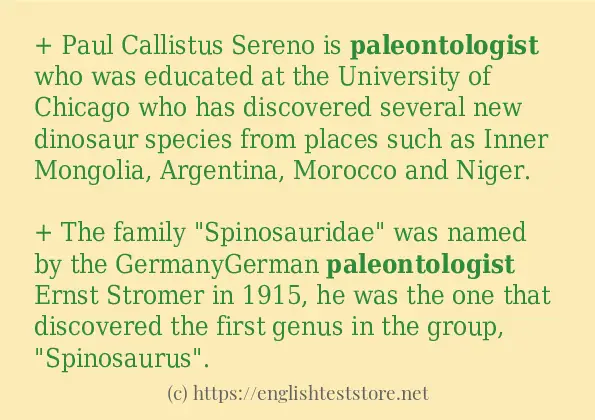How to use in-sentence of “paleontologist”:
+ Paul Callistus Sereno is paleontologist who was educated at the University of Chicago who has discovered several new dinosaur species from places such as Inner Mongolia, Argentina, Morocco and Niger.
+ The family “Spinosauridae” was named by the GermanyGerman paleontologist Ernst Stromer in 1915, he was the one that discovered the first genus in the group, “Spinosaurus”.
+ The team leader, paleontologist Barnum Brown, was primarily concerned with excavating and preparing the remains of the ornithopod dinosaur “Tenontosaurus”, but in his field report from the dig site to the American Museum of Natural History, he reported the discovery of a small carnivorous dinosaur close to a “Tenontosaurus” skeleton, “but encased in lime difficult to prepare.” He informally called the animal “Daptosaurus agilis” and made preparations for describing it and having the skeleton, specimen AMNH 3015, put on display, but never finished this work.
+ The type species “Chuandongocoelurus primitivus” was first described and named by Chinese paleontologist He Xinlu in 1984.
+ The first specimens were found in Niger in 1973 by a french paleontologist named Philippe Taquet.
+ It was named by paleontologist Jose Bonaparte in 1991.

Example sentences of “paleontologist”:
+ Gerd van den Bergh, a paleontologist working with the fossils, reported hearing of the Ebu Gogo ten years before the fossil discovery.
+ It was discovered by the paleontologist O.C.
+ It was named by paleontologist Sankar Chatterjee after Shiva, the Hindu god of destruction and renewal.
+ Gerd van den Bergh, a paleontologist working with the fossils, reported hearing of the Ebu Gogo ten years before the fossil discovery.
+ It was discovered by the paleontologist O.C.
+ It was named by paleontologist Sankar Chatterjee after Shiva, the Hindu god of destruction and renewal.
+ Leakey PhD DSc is a renowned paleontologist who studies the origin of mankind in West Africa.
+ It was a bipedal herbivore described by Argentine paleontologist Rodolfo Casamiquela in 1967.
+ The remains are currently under excavation by paleontologist Peter Larson and a team from the Black Hills Institute.
+ In the 1870s, the famous American paleontologist Edward Drinker Cope discovered another, more complete set of fossils in North America, and named them “Diatryma”.Cope, Edward Drinker 1876.
+ The first study on the evolution of the dhole was conducted by paleontologist Erich Thenius, who found that dholes descend from an animal which looked like a golden jackal and which lived in the Pleistocene.
+ This Ice ageice-age mammal was the largest of the ground sloths; Megatherium’s name means “great beast.” Megatherium was named by paleontologist Richard Owen in 1856; the first Megatherium fossil was found in Brazil in 1789.
+ There are a number of other suspects, including Sir Arthur Smith Woodward, Keeper of the British Museum’s Natural History department, and Pierre Teilhard de Chardin, a paleontologist and Jesuit theologian.
+ Victoria “Tori” Herridge is a female paleontologist who was born in Britain.
+ On 7th June 2013 Science said that Pascal Godefroit, the paleontologist who led the team that described “Aurornis”, is uncertain if the fossil material came from Liaoning province’s 160-million-year-old Tiaojishan Formation as claimed by the fossil dealer.
+ Her daughter Louise Leakey is also a paleontologist studying human origins.
+ It was found and named by a CanadaCanadian paleontologist called Dale Russel in 1996, he found the fossils in Morocco at a fossil site called the Kem Kem Formation.
+ But in 1998, paleontologist Angela Milner was publishing a new description of “Baryonyx”, and she realized that the teeth of that spinosaurid dinosaur were extremely similar to those from “Suchosaurus”.
+ According to a paleontologist at the Smithsonian “for almost a hundred years, the presence of oviraptorosaurs in North America was only known from a few bits of skeleton, and the details of their appearance and biology remained a mystery.
+ At the start of the 19 century, American paleontologist Charles Doolittle Walcott noticed differences in early Paleozoic benthic trilobites either side of the line which later was called the Iapetus Suture.
